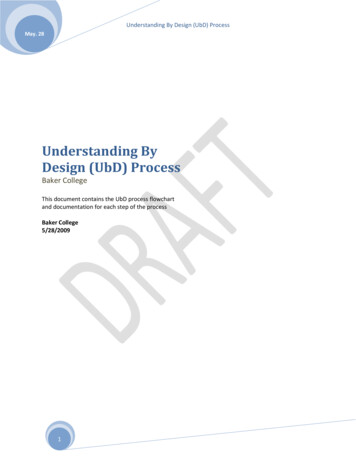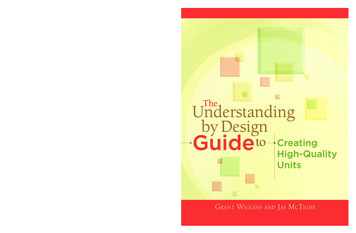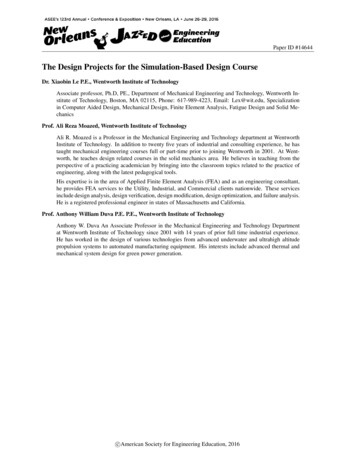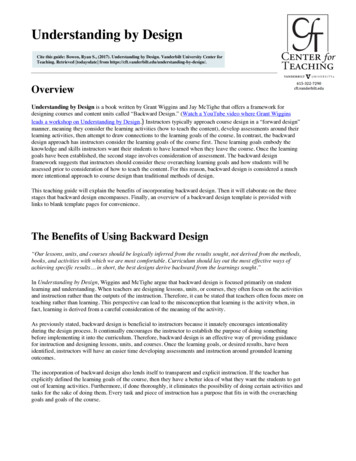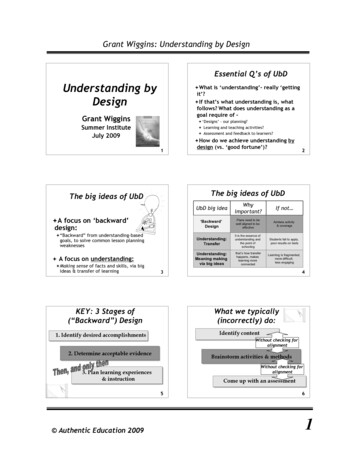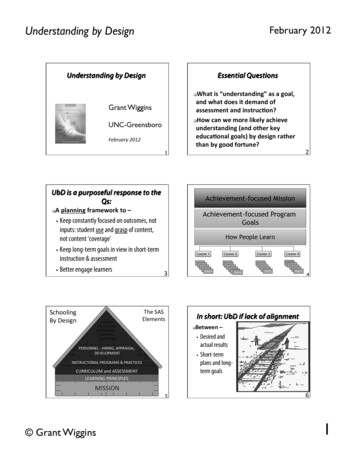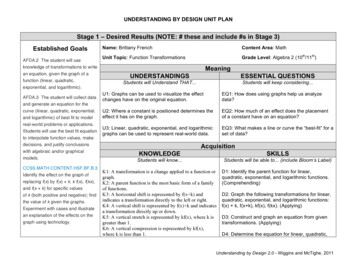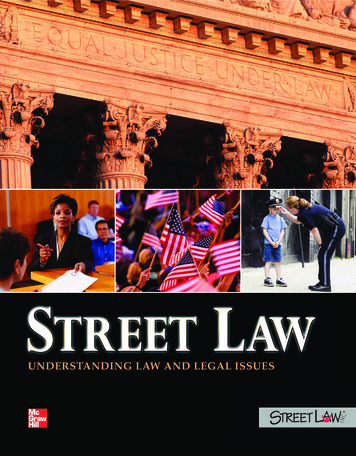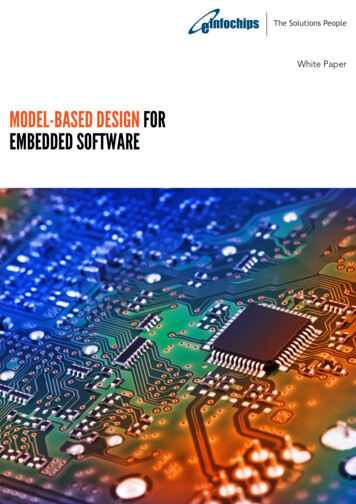
Transcription
(Based on Understanding by Design by Wiggins and McTighe)Unit BackgroundCourse:Unit TitleUnit #6th Grade ELAUnit 1: Fiction and Nonfiction1Days:30Unit Reviewer (s):Unit Designer:Resources Used:Pearson Reading Journey CurriculumUnit Vision and Narrative Description:Unit 1 is an important foundation for student’s later work with Literary concepts. Students will learn theprediction reading comprehension strategy. They will understand the difference between fiction andnonfiction. They will make connections to the author and their point of view. Students will also extend theirprior knowledge of grammar and writing create rough drafts of writing. They will use skills learned in this unitto critique and enhance their writing as well as others.Stage 1: Big GoalsAssessment Standards:Reading: Literacy TextRL.6.9 Compare and contrast texts in different forms or genres in terms of their approaches to similarthemes and topicsRL.6.4 Determine the meaning of words and phrases as they are used in a text; including figurative andconnotative meanings; analyze the impact of a specific word choice on the meaning and tone.Reading: Informational TextRI.6.1 Cite textual evidence to support analysis of what the text says explicitly as well as inferences drawnfrom the text.RI.6.6 Determine an author’s point of view or purpose in a text and explain how it is conveyed in the text.Language StandardsL.6.1. Demonstrate command of the conventions of standard English grammar and usage with writing orspeaking.L6.2. Demonstrate command of the conventions of standard English capitalization, punctuation, andspelling when writing.L6.3. Use knowledge of language and its conventions when writing, speaking, reading or listening.L.6.5 Demonstrate understanding of figurative language, word relationships, and nuances in wordmeaning.Writing StandardsW.6.3. Write a narrative to develop real or imagined experiences or events using effective technique,relevant descriptive details, and well – structured event sequences.W.6.5. With some guidance and support from peers and adults, develop and strengthen writing as neededby planning, revising, editing, rewriting, or trying a new approach.W.6.6. Use technology, including the Internet, to produce and publish writing as well as to interact andcollaborate with others; demonstrate sufficient command of keyboarding skills to type a minimum ofthree pages in a single sitting.Speaking and Listening StandardsS.6.1. Engage effectively in a range of collaborative discussions with diverse partners on grade 6 topics,texts, and issues, building on others’ ideas and expressing their own clearly.S.6.4 Present claims and findings, sequencing ideas logically and using pertinent descriptions, facts, anddetails to accentuate main ideas or themes; use appropriate eye contact, adequate volume, and clearpronunciationContent Limitations(N/A – no content limitationsnecessary).
Enduring Understandings:I can identify the difference between fiction and nonfiction texts.I can predict before and while reading text.I can identify narrative texts.I can to identify imagery in text.I can interpret symbolism in a text.I can classify statements as fact or opinion.I can explain how authors convey their point of view in a textI can categorize different types of nounsI can identify pronouns in their proper case (subject, objective and possessive)I can compose an Autobiographical NarrativeI can conduct research and use it to create a news report with power point.Essential Questions:Unit Big Question: How do we decide what is true? What is the difference between fiction and nonfiction?How can the prediction strategy enhance comprehension?Why do authors use symbolism and imagery in text?What are the different ways nouns and pronouns are categorized?What steps are necessary to create a well written autobiographical narrative?Stage 2: End in MindAssessment:
Formative – Textbooks tasks Writing Journal Daily Grammar Vocabulary Homework Class work Participation Graphic OrganizersSummative – Lesson Quizzes Chapter Tests CumulativeAssessments Writing RubricsTrack -KnowledgeKnowledgeAcademic VocabularyLiteracy Concepts:Fiction and NonfictionNarrative TextsFictionNonfictionPredictionPrefixesRoot wordAuthorPoint of ViewNarrativeImagerySensoryInformational TextAutobiographical NarrativePunctuationCommon NounsProper NounSingular NounPlural NounPossessive lPossessiveAntecedentLanguage Concepts:NounsPronounsWriting:Autobiographical NarrativeTell -
Part 3 – Schedule Learning ExperiencesDayAimLearning Experience(s)(include assessment days)Brief description of how you’ll approach this aimVocabularyPotentialMisconception(s)Sample Assessment Item1Introduction to Fictionand Nonfiction(RL.6.9)Power point on definitions anddistinctions. Review exampleswhole group.FictionNonfictionStudents may associate theprefix Non to mean nottrue.Read samples of fiction andnonfiction and identify themcorrectly.2Reading Skills:Making Predictions(RL.6.4)Discuss Prediction strategy.Read Passage together wholegroup pausing for volunteerpredictions using graphicorganizerPredictionHesitation to makingincorrect predictionsSummarize the reading usinggraphic organizer after usingprediction strategy.3Vocabulary BuildingSkills:Prefixes (L.6.5)PrefixesRoot wordCannot identify thedifference between the rootword and prefixUnderline the prefix in a wordand state how it connects tothe definition of the word.4ReviewReview lessons from days1-3.FictionNonfictionPredictionPrefixesRoot wordWhat is the prefix in the wordNonfiction and how itconnects to the definition ofthe word.5EvaluateLesson QuizFictionNonfictionPredictionPrefixesRoot wordRead the passage using theprediction strategy. Identifywhere the passage was afiction or nonfiction word.6Author’s Point ofView(RI.6.6.)Reader’s Journal ActivitiesAuthorPoint of ViewJournal Reflection: How didthe author’s point of viewaffect the story?7-9Reading NarrativeTexts. (RI.6.1)NarrativeAnswer questions from thestories using contextual
evidence.10-11Sensory Language:Imagery (RL.6.4)ImagerySensoryUnderline words or phrases inthe passage that invokesimagery.12Reading Skill: AnalyzingInformational Text:EmploymentApplication (RI.6.1.)Writer’s Workshop:Write r Edit (W.6.5)(L.6.2) (S.6.1.)InformationalTextAnswer questions on thepassage using contextualevidence.1314Autobiographical NarrativeWhole group peer edit lesson,small group peer edit othersworkPunctuation15Grammar:Nouns (L.6.1.)CommonNounsProper NounSingular NounPlural NounPossessiveNouns16Grammar:Nouns (L.6.1.)17Nouns EvaluationCommonNounsProper NounSingular NounPlural NounPossessiveNouns18-22Literature Circles:Symbolism (S.6.1.)SymbolismPeer edit Rubric.
23Literature CircleProject Presentation(S.6.4.) (L.6.3)Reading Skills:Fact and OpinionSymbolismLiterary Analysis:Narrator and Point ofView (RI.6.6.)Writers Workshop:Research (W.6.6.)NarratorPoint of 28Pronouns EvaluationPersonalPossessiveAntecedent29Unit Review30Unit Assessment242526FactOpinionResearchPlagiarism
Unit BackgroundCourse:Unit TitleUnit #6th Grade ELAUnit 2: The Novel2Unit Reviewer (s):Unit Designer:Resources Used:Pearson Reading Journey CurriculumUnit Vision and Narrative Description:Stage 1: Big GoalsAssessment Standards:Reading: Literacy TextRL.6.3. Describe how a particular story’s or drama’s plot unfolds in aseries of episodes as well as how the characters respond or changeas the plot moves towards a resolution.RL.6.5. Analyze how a particular sentence, chapter, scene or stanzafits into the overall structure of a text and contributes to thedevelopment of the theme, setting or plot.RL.6.7. Compare and contrast the experience of reading a story,drama or poem to listening to or viewing an audio, video, or liveversion of the text, including contrasting what they “see” and “hear:when reading the text to what they perceive when they listen.Reading: Informational TextRI.6.5. Analyze how a particular sentence, paragraph, chapter, orsection fits into the overall structure of a text and contributes to thedevelopment of the ideas.RI.6.9. Compare and contrast one author’s presentation of eventswith that of another.Language StandardsL.6.1. Demonstrate command of the conventions of standard Englishgrammar and usage when writing or speaking.L.6.2. Demonstrates command of the conventions of standardEnglish capitalization, punctuation, and spelling when writing.L.6.3. Use knowledge of language and its conventions when writing,Content Limitations(N/A – no content limitations necessary).Days:
speaking, reading or listening.Writing StandardsW.6.1. Write narratives to develop real or imagined experiences orevents using effective technique, relevant descriptive details, andwell structured event sequences.W.6.4. Produce clear and coherent writing in which thedevelopment, organization, and style are appropriate to task,purpose and audience.W.6.5. With some guidance and support from peers and adults,develop and strengthen writing as needed by planning, revising,editing, rewriting, or trying a new approach.Speaking and Listening StandardsS.6.1. Engage effectively in a range of collaborative discussions withdiverse partners on grade 6 topics, texts, and issues, building onothers’ ideas and expressing their own clearly.S.6.4. Present claims and findings, sequencing ideas logically andusing pertinent descriptions, facts and details to accentuate mainideas or themes; use appropriate eye contact, adequate volume, andclear pronunciation.Enduring Understandings:I can identify the different components of a story.I can make inferences to increase my comprehensionI can categorize and compare characters in a story.I can identify a character’s motivesI can discuss different types of conflict in a story.I can draw conclusions based on information given to me.I can analyze how a specific scene contributes to the overall development of the plot.I can manipulate words by adding or detaching suffixesI can use verbs properly in written text.I can compose and present a compare and contrast essay.I can use my knowledge of story elements to compose a short storyEssential Questions:Is conflict always bad?
Stage 2: End in MindAssessment:Formative – Textbooks tasks Writing Journal Daily Grammar Vocabulary Homework Class work Participation Graphic OrganizersSummative – Lesson Quizzes Chapter Tests CumulativeAssessments Writing RubricsTrack -KnowledgeKnowledgeAcademic VocabularyTell -
Part 3 – Schedule Learning ExperiencesDayAimLearning Experience(s)(include assessment days)Brief description of how you’ll approach this aimVocabularyPotentialMisconception(s)Unit BackgroundCourse:Unit TitleUnit #6th Grade ELAUnit 3: Nonfiction3Unit Reviewer (s):Unit Designer:Resources Used:Pearson Reading Journey CurriculumUnit Vision and Narrative Description:Stage 1: Big GoalsAssessment Standards:Reading: Literacy TextN/AReading: Informational TextRI.6.2. Determine a central idea of a text and how it is conveyedthrough particular details; provide a summary of the text distinctfrom personal opinions or judgments.RI.6.8. Trace and evaluate the argument and specific claims in a text,distinguishing claims that are supported by reasons and evidencefrom claims that are not.RI.6.9. Compare and contrast one author’s presentation of eventswith that of anotherLanguage StandardsL.6.1. Demonstrate command of the conventions of standard Englishgrammar and usage when writing or speakingL.6.2. Demonstrate command of the conventions of standard Englishcapitalization, punctuation, and spelling when writingL.6.3. Use knowledge of language and its conventions when writing,speaking, reading, or listeningL.6.4. Determine or clarify the meaning of unknown and multiplemeaning words and phrases based on grade 6 reading and content,choosing flexibility from a range of strategies.Writing StandardsW.6.1. Write arguments to support claims with clear reasoning andrelevant evidenceW.6.2. Write informative/explanatory texts to examine a topic andconvey ideas, concepts, and information through the selection,Content Limitations(N/A – no content limitations necessary).Days:S
organization, and analysis of relevant context.W.6.4. Produce clear and coherent writing in which thisdevelopment, organization, and style are appropriate to task,purpose, and audienceW.6.5. With some guidance and support from peers and adults,develop and strengthen writing as needed by planning, revising,editing, rewriting, or trying a new approach.Enduring Understandings:I can use text structure in nonfiction literature to increase my comprehensionI can identify the main idea and supporting details without offering my own opinion on the topicI can compose an essay giving directions on how to complete a taskI can identify the author’s purpose of a textI can compose a persuasive essay using supporting details relative to my topicI can recognize word roots to help me determine its meaningI can identify adjectives in a sentenceI can identify adverbs in a sentenceExposition: How to EssayPersuasion: Persuasive EssayEssential Questions:What is important to know?Stage 2: End in MindAssessment:Formative – Textbooks tasks Writing Journal Daily Grammar Vocabulary Homework Class work Participation Graphic OrganizersSummative – Lesson Quizzes Chapter Tests CumulativeAssessments Writing RubricsTrack -KnowledgeKnowledgeAcademic VocabularyTell -
Part 3 – Schedule Learning ExperiencesDayAimLearning Experience(s)(include assessment days)Brief description of how you’ll approach this aimVocabularyPotentialMisconception(s)Unit BackgroundCourse:Unit TitleUnit #6th Grade ELAUnit 4: Poetry and Prose4Unit Reviewer (s):Unit Designer:Resources Used:Pearson Reading Journey CurriculumUnit Vision and Narrative Description:Stage 1: Big GoalsAssessment Standards:Reading: Literacy TextRL.6.1. Cite textual evidence to support analysis of what the text saysexplicitly as well as inferences drawn from the text.RL.6.4. Determine the meaning of words and phrases as they areused in a text, including figurative and connotative meanings,analyzes the impact of a specific word choice on meaning and tone.RL.6. Analyze how a particular sentence, chapter, scene, or stanzafits into the overall structure of a text and contributes to thedevelopment of the theme, settings, or plot.RL.6.6. Explain how an author develops the point of view of thenarrator or speaker in a textReading: Informational TextN/ALanguage StandardsL.6.1. Demonstrate command of the conventions of standard Englishgrammar and usage when writing or speakingL.6.2. Demonstrate command of the conventions of standard Englishcapitalization, punctuation, and spelling when writingL.6.3. Use knowledge of language and its conventions when writing,speaking, reading, or listeningL.6.5.a. Interpret figures of speech in context.Writing StandardsW.6.3.d. Use precise words and phrases, relevant descriptive details,and sensory language to convey experiences or events.W.6.4. Produce clear and coherent writing in which thisdevelopment, organization, and style are appropriate to task,Content Limitations(N/A – no content limitations necessary).Days:S
purpose, and audienceW.6.5. With some guidance and support from peers and adults,develop and strengthen writing as needed by planning, revising,editing, rewriting, or trying a new approach.Speaking and Listening StandardsEnduring Understandings:I can participate in a discussion based on poemsI can identify and interpret idioms and multiple meaning words and phrasesI can identify and interpret multiple forms of figurative languageI can recognize the use of imagery in a poemI can determine the point of view of a poemI can use context clues to help determine the meaning of a word.I can analyze how the use of sound devices enhance a poemI can identify different forms of poetryI can differentiate between simple and compound subjectsI can read a poem aloud with appropriate toneI can compose a descriptive essay using my knowledge of figurative language and imageryI can compose a narration poemEssential Questions:Do we need words to communicate?Stage 2: End in MindAssessment:Formative – Textbooks tasks Writing Journal Daily Grammar Vocabulary Homework Class work Participation Graphic OrganizersSummative – Lesson Quizzes Chapter Tests CumulativeAssessments Writing RubricsTrack -KnowledgeKnowledgeAcademic VocabularyTell -
Part 3 – Schedule Learning ExperiencesDayAimLearning Experience(s)(include assessment days)Brief description of how you’ll approach this aimVocabularyPotentialMisconception(s)Unit BackgroundCourse:Unit TitleUnit #6th Grade ELAUnit 5: Drama5Unit Reviewer (s):Unit Designer:Resources Used:Pearson Reading Journey CurriculumUnit Vision and Narrative Description:Stage 1: Big GoalsAssessment Standards:Content Limitations(N/A – no content limitations necessary).Enduring Understandings: Essential Questions:How do we decide who we are?Stage 2: End in MindAssessment:Days:S
Formative – Textbooks tasks Writing Journal Daily Grammar Vocabulary Homework Class work Participation Graphic OrganizersSummative – Lesson Quizzes Chapter Tests CumulativeAssessments Writing RubricsTrack -KnowledgeKnowledgeAcademic VocabularyTell -
Part 3 – Schedule Learning ExperiencesDayAimLearning Experience(s)(include assessment days)Brief description of how you’ll approach this aimVocabularyPotentialMisconception(s)Unit BackgroundCourse:Unit TitleUnit #6th Grade ELAUnit 6: The Research Process6Unit Reviewer (s):Unit Designer:Resources Used:Pearson Reading Journey CurriculumUnit Vision and Narrative Description:Stage 1: Big GoalsAssessment Standards:Content Limitations(N/A – no content limitations necessary).Enduring Understandings: Essential Questions:How much should our community shape us?Stage 2: End in MindAssessment:Days:S
Formative – Textbooks tasks Writing Journal Daily Grammar Vocabulary Homework Class work Participation Graphic OrganizersSummative – Lesson Quizzes Chapter Tests CumulativeAssessments Writing RubricsTrack -KnowledgeKnowledgeAcademic VocabularyTell -
Part 3 – Schedule Learning ExperiencesDayAimLearning Experience(s)(include assessment days)Brief description of how you’ll approach this aimVocabularyPotentialMisconception(s)Sample Assessment Item
(Based on Understanding by Design by Wiggins and McTighe) Unit Background Course: 6th Grade ELA Unit # 1 Days: 30 Unit Title Unit 1: Fiction and Nonfiction Unit Designer: Unit Reviewer (s): Resources Used: Pearson Reading Journey Curriculum Unit Vision and Narrative Description: Unit 1 is

